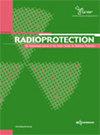神经外科儿科患者医学影像的有效剂量是多少?
IF 1.8
4区 医学
Q4 ENVIRONMENTAL SCIENCES
引用次数: 0
摘要
使用电离辐射进行医学成像的儿科患者越来越多,他们的辐射敏感性是成人的2-3倍。本研究的目的是估计儿科神经外科患者CT扫描和x线平片的总有效剂量(ED)。包括至少一次脑CT扫描和记录剂量长度积(DLP)的患者。从图像存档和通信系统(PACS)中收集患者的影像数据,使用其国家代码查找其所有医学影像。计算CT平片和x线平片的总ED (mSv)。共纳入300例患者,其中女性129例,男性171例,平均年龄5.45±4.34岁。脑、腹、胸部CT平均dlp分别为329.16、393.06、284.46 mg .cm。这些儿童中最常见的CT扫描是脑部CT扫描,ED范围为0.09至47.09 mSv。所有CT平片和x线平片显示的ED在0.38 - 63.41 mSv之间。尽管患者每次脑部、胸部和腹部CT的平均DLP在先前研究报告的drl范围内,但多次CT扫描的患者接受的辐射剂量高于平均ED(所有年龄组之间为6.21 mSv)。最常见的CT扫描是脑部,最常见的x线平片是胸部和下肢。由此得出结论,通过适当的体格检查减少CT扫描或x线平片的次数或用不使用电离辐射的方式代替它们可以减少ED。本文章由计算机程序翻译,如有差异,请以英文原文为准。
How much is the effective dose from medical imaging in pediatric patients in the neurosurgery department?
Medical imaging with ionizing radiation in pediatric patients is rising, and their radiation sensitivity is 2–3 times more than adults. The objective of this study was to estimate the total effective dose (ED) of all medical imaging by CT scan and plain radiography in patients in pediatric neurosurgery department. Patients with at least one brain CT scan and recorded dose length product (DLP) were included. Patients’ imaging data were collected from the picture-archiving-and-communicating system (PACS) using their national code to find all their medical imaging. Total ED (mSv) from CT scans and plain radiographs were calculated. A total of 300 patients were included, of which 129 were females and 171 males with a mean age of 5.45 ± 4.34 years. Mean DLPs of brain, abdomen, and chest CT were 329.16, 393.06, 284.46 mGy.cm. The most frequent CT scans in these children were brain CT scans with ED range of 0.09 to 47.09 mSv. Total ED due to all CT scans and plain radiographs were in the range of 0.38 to 63.41 mSv. Although the mean DLP of each brain, chest, and abdomen CT of patients was in the range of DRLs reported by previous studies, the patients with numerous CT scans received more radiation doses than mean ED (6.21 mSv between all age groups). The most frequent CT scan was the brain, and the most frequent plain radiographs were chest and lower extremities. It can be concluded that reducing the number of CT scans or plain radiographs by appropriate physical exams or replacing them with modalities that do not use ionizing radiation can reduce ED.
求助全文
通过发布文献求助,成功后即可免费获取论文全文。
去求助
来源期刊

Radioprotection
ENVIRONMENTAL SCIENCES-PUBLIC, ENVIRONMENTAL & OCCUPATIONAL HEALTH
CiteScore
3.30
自引率
54.50%
发文量
35
审稿时长
>12 weeks
期刊介绍:
Radioprotection publishes articles on all aspects of radiological protection, including non-ionising as well as ionising radiations. Fields of interest range from research, development and theory to operational matters, education and training. The very wide spectrum of its topics includes (theoretical and practical aspects): dosimetry, instrument development, specialized measuring techniques, epidemiology, biological effects (in vivo and in vitro) and risk and environmental impact assessments.
 求助内容:
求助内容: 应助结果提醒方式:
应助结果提醒方式:


